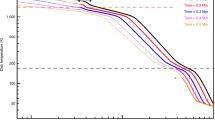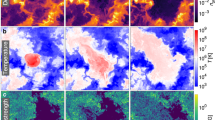Abstract
Dusty disks around young stars are formed out of interstellar dust that consists of amorphous, submicrometre grains. Yet the grains found in comets1 and meteorites2, and traced in the spectra of young stars3, include large crystalline grains that must have undergone annealing or condensation at temperatures in excess of 1,000 K, even though they are mixed with surrounding material that never experienced temperatures as high as that4. This prompted theories of large-scale mixing capable of transporting thermally altered grains from the inner, hot part of accretion disks to outer, colder disk regions5,6,7, but all have assumptions that may be problematic8,9,10,11,12. Here I report that infrared radiation arising from the dusty disk can loft grains bigger than one micrometre out of the inner disk, whereupon they are pushed outwards by stellar radiation pressure while gliding above the disk. Grains re-enter the disk at radii where it is too cold to produce sufficient infrared radiation-pressure support for a given grain size and solid density. Properties of the observed disks suggest that this process might be active in almost all young stellar objects and young brown dwarfs.
This is a preview of subscription content, access via your institution
Access options
Subscribe to this journal
Receive 51 print issues and online access
$199.00 per year
only $3.90 per issue
Buy this article
- Purchase on Springer Link
- Instant access to full article PDF
Prices may be subject to local taxes which are calculated during checkout



Similar content being viewed by others
References
Brownlee, D. et al. Comet 81P/Wild 2 under a microscope. Science 314, 1711–1716 (2006)
Wooden, D. H., Harker, D. E. & Brearley, A. J. in Chondrites and the Protoplanetary Disk (eds Krot, A. N., Scott, E. R. D. & Reipurth, B.) 774–808 (ASP Conference Series Vol. 341, 2005)
van Boekel, R. et al. The building blocks of planets within the ‘terrestrial’ region of protoplanetary disks. Nature 432, 479–482 (2004)
Hill, H. G. M., Grady, C. A., Nuth, J. A., Hallenbeck, S. L. & Sitko, M. L. Constraints on nebular dynamics and chemistry based on observations of annealed magnesium silicate grains in comets and in disks surrounding Herbig Ae/Be stars. Proc. Natl Acad. Sci. USA 98, 2182–2187 (2001)
Shu, F. H., Shang, H. & Lee, T. Toward an astrophysical theory of chondrites. Science 271, 1545–1552 (1996)
Ciesla, F. J. Outward transport of high-temperature materials around the midplane of the solar nebula. Science 318, 613–615 (2007)
Boss, A. P. Mixing in the solar nebula: Implications for isotopic heterogeneity and large-scale transport of refractory grains. Earth Planet. Sci. Lett. 268, 102–109 (2008)
Klahr, H., Różyczka, M., Dziourkevitch, N., Wünsch, R. & Johansen, A. in Planet Formation (eds Klahr, H. & Brandner, W.) 42–63 (Cambridge Univ. Press, 2006)
Hubickyj, O. in Planet Formation (eds Klahr, H. & Brandner, W.) 163–178 (Cambridge Univ. Press, 2006)
Matsumura, S. & Pudritz, R. E. Dead zones and extrasolar planetary properties. Mon. Not. R. Astron. Soc. 365, 572–584 (2006)
Shang, H., Li, Z.-Y. & Hirano, N. in Protostars and Planets V (eds Reipurth, B., Jewitt, D. & Keil, K.) 261–276 (Univ. Arizona Press, 2007)
Boss, A. P. Evolution of the solar nebula. VII. Formation and survival of protoplanets formed by disk instability. Astrophys. J. 629, 535–548 (2005)
Takeuchi, T. & Lin, D. N. C. Surface outflow in optically thick dust disks by radiation pressure. Astrophys. J. 593, 524–533 (2003)
Vinković, D. Temperature inversion on the surface of externally heated optically thick multigrain dust clouds. Astrophys. J. 651, 906–913 (2006)
Millan-Gabet, R. et al. in Protostars and Planets V (eds Reipurth, B., Jewitt, D. & Keil, K.) 539–554 (Univ. Arizona Press, 2007)
Vinković, D. & Jurkić, T. Relation between the luminosity of young stellar objects and their circumstellar environment. Astrophys. J. 658, 462–479 (2007)
Isella, A. & Natta, A. The shape of the inner rim in proto-planetary disks. Astron. Astrophys. 438, 899–907 (2005)
Alexander, R. From discs to planetesimals: Evolution of gas and dust discs. N. Astron. Rev. 52, 60–77 (2008)
Chiang, E. I. & Goldreich, P. Spectral energy distributions of T Tauri stars with passive circumstellar disks. Astrophys. J. 490, 368–376 (1997)
Fujiwara, D. & Watanabe, S. Protostars and Planets V, Proceedings of the Conference 8237 (Lunar and Planetary Institute, 2005)
Voshchinnikov, N. V. & Henning, T. Is the silicate emission feature only influenced by grain size? Astron. Astrophys. 483, L9–L12 (2008)
Pinte, C. et al. Probing dust grain evolution in IM Lupi's circumstellar disc. Multi-wavelength observations and modelling of the dust disc. Astron. Astrophys. 489, 633–650 (2008)
Jones, R. H., Lee, T., Connolly, H. C., Love, S. G. & Shang, H. in Protostars and Planets IV (eds Mannings, V., Boss, A. P. & Russell, S. S.) 927–962 (Univ. Arizona Press, 2000)
Wuchterl, G. & Tscharnuter, W. M. From clouds to stars. Protostellar collapse and the evolution to the pre-main sequence I. Equations and evolution in the Hertzsprung-Russell diagram. Astron. Astrophys. 398, 1081–1090 (2003)
van Boekel, R. et al. A 10 μm spectroscopic survey of Herbig Ae star disks: Grain growth and crystallization. Astron. Astrophys. 437, 189–208 (2005)
Sargent, B. et al. Dust processing in disks around T Tauri stars. Astrophys. J. 645, 395–415 (2006)
Watson, D. M. et al. Crystalline silicates and dust processing in the protoplanetary disks of the Taurus young cluster. Astrophys. J. Suppl. Ser. 180, 84–101 (2009)
Schegerer, A. A., Wolf, S., Ratzka, Th. & Leinert, Ch. The T Tauri star RY Tauri as a case study of the inner regions of circumstellar dust disks. Astron. Astrophys. 478, 779–793 (2008)
Dorschner, J., Begemann, B., Henning, T., Jaeger, C. & Mutschke, H. Steps toward interstellar silicate mineralogy. II. Study of Mg-Fe-silicate glasses of variable composition. Astron. Astrophys. 300, 503–520 (1995)
Jaeger, C. et al. Steps toward interstellar silicate mineralogy. IV. The crystalline revolution. Astron. Astrophys. 339, 904–916 (1998)
Acknowledgements
I thank the Institute for Advanced Study in Princeton and the University Computing Center SRCE in Zagreb for time on their computer clusters.
Author information
Authors and Affiliations
Corresponding author
Supplementary information
Supplementary Information
This file contains Supplementary Data and Supplementary References. (PDF 152 kb)
Rights and permissions
About this article
Cite this article
Vinković, D. Radiation-pressure mixing of large dust grains in protoplanetary disks. Nature 459, 227–229 (2009). https://doi.org/10.1038/nature08032
Received:
Accepted:
Issue Date:
DOI: https://doi.org/10.1038/nature08032
This article is cited by
-
The underexposed effect of elastic electron collisions in dusty plasmas
Communications Physics (2021)
-
Understanding planet formation using microgravity experiments
Nature Reviews Physics (2021)
-
On the Origin and Evolution of the Material in 67P/Churyumov-Gerasimenko
Space Science Reviews (2020)
-
Interplanetary Dust, Meteoroids, Meteors and Meteorites
Space Science Reviews (2019)
-
Comet-like mineralogy of olivine crystals in an extrasolar proto-Kuiper belt
Nature (2012)
Comments
By submitting a comment you agree to abide by our Terms and Community Guidelines. If you find something abusive or that does not comply with our terms or guidelines please flag it as inappropriate.



